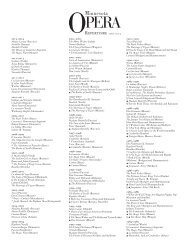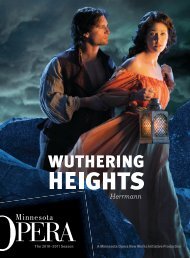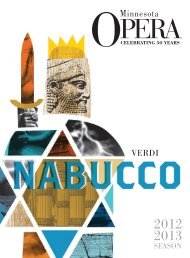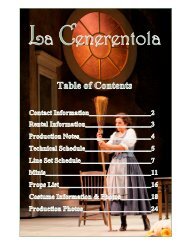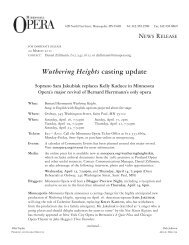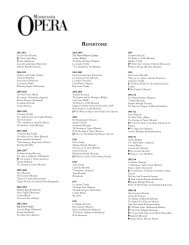You also want an ePaper? Increase the reach of your titles
YUMPU automatically turns print PDFs into web optimized ePapers that Google loves.
The <strong>Grapes</strong> of Wrath <strong>Opera</strong> Box<br />
lesson plan<br />
title of lesson<br />
Lesson 3: Exploring the libretto<br />
objective(s)<br />
Students will understand the major characters and their development through the story. They will also be able to<br />
identify the major motives, themes and images of the story.<br />
material(s)<br />
• LIBRETTO The <strong>Grapes</strong> of Wrath (one per student)<br />
• BOOK The <strong>Grapes</strong> of Wrath (one per student) – optional<br />
procedure(s)<br />
This section of the study guide is designed to acquaint you and your students with the main characters of the opera<br />
and their development, as well as with the opera’s structure and its major motifs, themes, and images. It assumes the<br />
students are not well acquainted with Steinbeck’s novel; however, it also tracks and cross-references the above topics<br />
within the original work itself so that the classes who are reading the book and seeing the opera can enrich their<br />
experiences with both through their integration, comparing and contrasting of the two genres. We suggest that the<br />
educator read the first Lisca essay (Appendix A) before guiding the students through the libretto.<br />
Specific aides to the educator will be parenthetical and labeled “NOTE.” Additional print and online resources can be<br />
found in Appendix D.<br />
act one<br />
PROLOGUE: A GREEN FIELD (The <strong>Grapes</strong> of Wrath, Chapter 1)<br />
(1) Notice that the curtain rises to the sound of “soft rain.” The musical section is entitled, “The Last Time There<br />
Was Rain.” Read the lyrics on p. 1. What picture is being painted of life on an Oklahoma farm during this time?<br />
What would you identify as the mood? What images reinforce this mood? Which actual words and phrases?<br />
(2) Look at the final stage direction on p. 1. Then move on to the first column on p. 2. What’s happening? What<br />
images does the librettist choose to show us the effect of the rain stopping?<br />
(3) Read the stage direction at the bottom of the first column. What’s happening now? Look at the images in the<br />
“All” section on the right of p. 2. What words are clues here as to the effect of the dust? (e.g. “thick as stew,”<br />
“weighted down the trees,” etc.) Note the colors mentioned on p. 2. How do they differ from the colors on p. 1?<br />
What is the feeling evoked by the men’s final section on p. 2: “… like bein’ on the moon … marooned”?<br />
(4) Read the women’s final stanza on p. 3. What is their observation about “fam’bly”?<br />
opera box lesson plans 14



